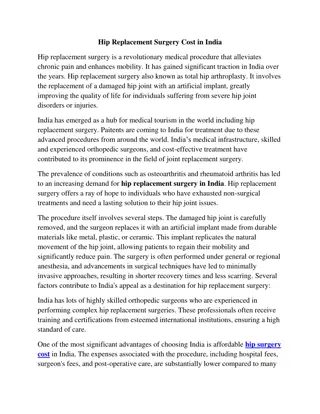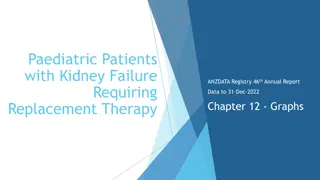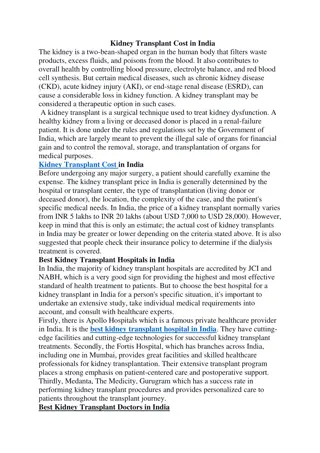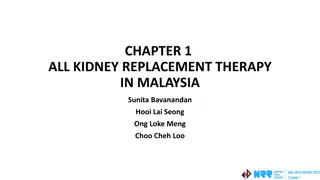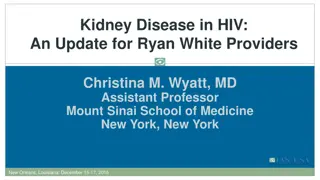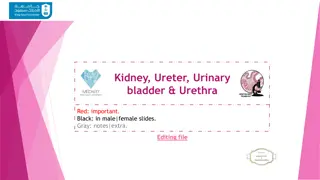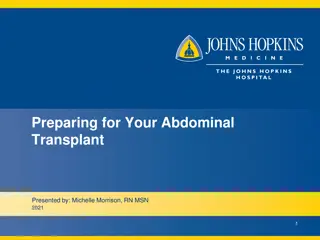KFRE: Validated Risk Prediction Tool for Kidney Replacement Therapy
KFRE, a validated risk prediction tool, aids in predicting the need for kidney replacement therapy in adults with chronic kidney disease. Developed in Canada in 2011, KFRE has undergone validation in over 30 countries, showing superior clinical accuracy in KRT prediction. Caution is advised when using online calculators due to UK-specific recalibration requirements. NICE guidelines recommend incorporating KFRE into primary care electronic health records for efficient risk assessment. Recalculation of KFRE is necessary based on eGFR and ACR measurements.
Download Presentation

Please find below an Image/Link to download the presentation.
The content on the website is provided AS IS for your information and personal use only. It may not be sold, licensed, or shared on other websites without obtaining consent from the author. Download presentation by click this link. If you encounter any issues during the download, it is possible that the publisher has removed the file from their server.
E N D
Presentation Transcript
KFRE is a well validated risk prediction tool for kidney replacement therapy (KRT, the need for dialysis or a kidney transplant), in the next two or five years for adults with chronic kidney disease (CKD) Stages 3A to 5 (eGFR <60 ml/min/1.73m2) The 4-variable KFRE is calculated from: Age in years Sex Estimated glomerular filtration rate (CKD-EPI eGFR) Urine albumin creatinine ratio (ACR) There is also an 8-variable KFRE which includes serum albumin, bicarbonate, calcium and phosphate but this will not be considered within this teaching module 2
KFRE was developed in Canada in 2011 and has undergone validation in more than a million individuals with CKD in over 30 countries, including the UK. A 2019 external validation study in primary care in the East Midlands showed that KFRE: was a statistically valid tool for KRT prediction (excellent statistical discrimination) required re-calibration for the UK (a common finding for all risk prediction tools) a KFRE predicted five year risk of >5% was clinically superior for identifying KRT and reducing referral eligibility compared to the 2014 primary to secondary care referral criteria of eGFR <30 ml/min/1.73m2 Based on this study, the 2021 update to the NICE guidelines (NG203) recommended the use of a KFRE 5-year risk of 5% rather than an eGFR of <30 ml/min/1.73m2
Due to the re-calibration for the UK, caution should be taken when using online KFRE calculators as they may use non-UK versions of the algorithm The NICE accredited link is available here and can be used in your local electronic health care records: https://www.nice.org.uk/guidance/ng203/resources/4variable-kidney-failure- risk-equation-calculator-excel-9253105597 It is anticipated that KFRE will be incorporated into primary care electronic health records to allow for automated calculation kfre.co.uk can be used and incorporates this updated algorithm 4
KFRE is valid in patients with diagnosed CKD stages 3a to 5 (eGFR <60 ml/min/1.73m2) Some existing websites allow input of an eGFR 60 ml/min/1.73m2, however KFRE is NOT VALID in this group of patients Recalculate KFRE when eGFR and ACR are re-measured. Frequency of measurements should be based on NICE s recommendations as shown in the table ACR Category A1 (<3mg/mmol) ACR category A2 3 to 30 mg/mmol ACR category A3 >30 mg/mmol eGFR stage Stage 3a eGFR 45 to 59 1 1 2 Stage 3b eGFR 30 to 44 1 to 2 2 2 or more Stage 4 eGFR 15 to 29 2 2 3 Stage 5 Under 15 4 4 or more 4 or more 5 NICE guidelines (NG203) - Table 2 Minimum number of monitoring checks (eGFRcreatinine) per year for adults, children and young people with or at risk of chronic kidney disease
KFRE is valid when eGFR and ACR measurements are valid i.e. in a steady state and NOT with rapidly changing eGFR such as with acute kidney injury. When eGFR is not in a steady state, other NICE referral criteria may be considered, such as: a sustained decrease in eGFR of 25% or more and a change in eGFR category within 12 months a sustained decrease in eGFR of 15 ml/min/1.73 m2or more per year Other factors that may affect the validity of KFRE include: eGFR extremes of weight/muscle mass, limb amputation and liver failure (see session on interpreting GFR) ACR presence of urinary tract infection, bladder catheterization (see session on albuminuria) Primary renal disease and kidney transplants - other risk prediction tools may be available for specific diseases, such as the International IgAN Prediction Tool 6
The 2021 NICE guideline Shared decision making - https://www.nice.org.uk/guidance/ng197 should be considered essential reading for all clinicians discussing KFRE, and any other risk, with patients and their carers. Explain risk in the context of each person's life and what matters to them Present risk over a defined time period i.e. for KFRE over two or five years Avoid terms such as 'risk', 'rare', 'unusual' and 'common these are interpreted in different ways by different people Use natural frequencies rather than percentages - 10 in 100 , NOT 10% Use the same denominator when comparing risk 7 in 100 for two year risk and 20 in 100 for five year risk NOT 1 in 14 for two year risk and 1 in 5 for five year risk Use both positive and negative framing your risk is 20 in 100 of needing dialysis or a transplant in the next five years your risk is 80 in 100 of NOT needing dialysis or a transplant in the next five years 7
Share and discuss the result with the patient, their family members and/or carers as appropriate. Consider a patient s wishes and co-morbidities in relation to their KFRE result, particularly if you are considering referral to secondary care. Consider referral to secondary care if a patient s KFRE five year risk is greater than 5%, or any of the other NICE criteria for referral. This replaces the previous referral criteria of an eGFR <30 ml/min/1.73m2 in the 2014 NICE guidelines. Repeat a KFRE calculation during annual check ups for other co-morbidities such as hypertension and/or diabetes, or more frequently depending on their CKD stage. 8
KFRE is a well validated risk prediction tool, recommended by NICE, for the prediction of KRT in the next two or five years in individuals with CKD Stages 3a to 5. KFRE uses age, sex, eGFR and ACR to make a KRT prediction. KFRE is not valid in individuals with rapidly changing kidney function such as acute kidney injury, and should be used with caution in individuals with extreme body weights, amputations, urinary tract infection and bladder catheters. KFRE results should be discussed with a patients using jargon free language e.g. your risk of needing dialysis or a kidney transplant is 10 in 100 in the next five years . Consider referral to secondary care if a patient s KFRE five year risk is greater than 5%. This replaces the previous referral criteria of an eGFR <30 ml/min/1.73m2 9





